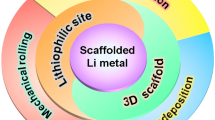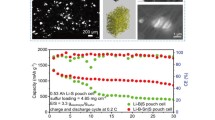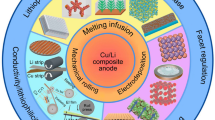Abstract
Lithium (Li) metal is believed to be the “Holy Grail” among all anode materials for next-generation Li-based batteries due to its high theoretical specific capacity (3860 mAh/g) and lowest redox potential (−3.04 V). Disappointingly, uncontrolled dendrite formation and “hostless” deposition impede its further development. It is well accepted that the construction of three-dimensional (3D) composite Li metal anode could tackle the above problems to some extent by reducing local current density and maintaining electrode volume during cycling. However, most strategies to build 3D composite Li metal anode require either electrodeposition or melt-infusion process. In spite of their effectiveness, these procedures bring multiple complex processing steps, high temperature, and harsh experimental conditions which cannot meet the actual production demand in consideration of cost and safety. Under this condition, a novel method to construct 3D composite anode via simple mechanical modification has been recently proposed which does not involve harsh conditions, fussy procedures, or fancy equipment. In this mini review, a systematic and in-depth investigation of this mechanical deformation technique to build 3D composite Li metal anode is provided. First, by summarizing a number of recent studies, different mechanical modification approaches are classified clearly according to their specific procedures. Then, the effect of each individual mechanical modification approach and its working mechanisms is reviewed. Afterwards, the merits and limits of different approaches are compared. Finally, a general summary and perspective on construction strategies for next-generation 3D composite Li anode are presented.
Similar content being viewed by others
References
Trahey L, Brushett F R, Balsara N P, et al. Energy storage emerging: A perspective from the Joint Center for Energy Storage Research. Proceedings of the National Academy of Sciences of the United States of America, 2020, 117(23): 12550–12557
Boudet H S. Public perceptions of and responses to new energy technologies. Nature Energy, 2019, 4(6): 446–455
Wu Y, Wang W, Ming J, et al. An exploration of new energy storage system: High energy density, high safety, and fast charging lithium ion battery. Advanced Functional Materials, 2019, 29(1): 1805978
He X, Bresser D, Passerini S, et al. The passivity of lithium electrodes in liquid electrolytes for secondary batteries. Nature Reviews. Materials, 2021, 6(11): 1036–1052
Matsumoto K, Hwang J, Kaushik S, et al. Advances in sodium secondary batteries utilizing ionic liquid electrolytes. Energy & Environmental Science, 2019, 12(11): 3247–3287
Zhang Z, Chen H, Hu Z, et al. Ion conduction path in composite solid electrolytes for lithium metal batteries: From polymer rich to ceramic rich. Frontiers in Energy, 2022, 16(5): 706–733
Xie J, Lu Y C. A retrospective on lithium-ion batteries. Nature Communications, 2020, 11(1): 2499
Wu F, Maier J, Yu Y. Guidelines and trends for next-generation rechargeable lithium and lithium-ion batteries. Chemical Society Reviews, 2020, 49(5): 1569–1614
Mennel J A, Chidambaram D. A review on the development of electrolytes for lithium-based batteries for low temperature applications. Frontiers in Energy, 2023, 17(1): 43–71
Duffner F, Kronemeyer N, Tübke J, et al. Post-lithium-ion battery cell production and its compatibility with lithium-ion cell production infrastructure. Nature Energy, 2021, 6(2): 123–134
Choi J W, Aurbach D. Promise and reality of post-lithium-ion batteries with high energy densities. Nature Reviews. Materials, 2016, 1(4): 16013
Duan J, Tang X, Dai H, et al. Building safe lithium-ion batteries for electric vehicles: A review. Electrochemical Energy Reviews, 2020, 3(1): 1–42
Bian Z, Tang Z, Xie J, et al. Preparation and lithium storage performances of g-C3N4/Si nanocomposites as anode materials for lithium-ion battery. Frontiers in Energy, 2020, 14(4): 759–766
Shen X, Liu H, Cheng X B, et al. Beyond lithium ion batteries: Higher energy density battery systems based on lithium metal anodes. Energy Storage Materials, 2018, 12: 161–175
Xing Z, Fu J, Chen S, et al. Perspective on gallium-based room temperature liquid metal batteries. Frontiers in Energy, 2022, 16(1): 23–48
Xiao J, Li Q, Bi Y, et al. Understanding and applying coulombic efficiency in lithium metal batteries. Nature Energy, 2020, 5(8): 561–568
Shan J, Yang X, Yan C, et al. Promoting Si-graphite composite anodes with SWCNT additives for half and NCM811 full lithium ion batteries and assessment criteria from an industrial perspective. Frontiers in Energy, 2019, 13(4): 626–635
Xia S, Wu X, Zhang Z, et al. Practical challenges and future perspectives of all-solid-state lithium-metal batteries. Chem, 2019, 5(4): 753–785
Wang Q, Liu B, Shen Y, et al. Confronting the challenges in lithium anodes for lithium metal batteries. Advanced Science (Weinheim, Baden-Wurttemberg, Germany), 2021, 8(17): 2101111
Qin K, Holguin K, Mohammadiroudbari M, et al. Strategies in structure and electrolyte design for high-performance lithium metal batteries. Advanced Functional Materials, 2021, 31(15): 2009694
Li G. Regulating mass transport behavior for high-performance lithium metal batteries and fast-charging lithium-ion batteries. Advanced Energy Materials, 2021, 11(7): 2002891
Wang S, Huang F, Jiao S, et al. Regulating surface chemistry of separator with LiF for advanced Li−S batteries. Frontiers in Energy, 2022, 16(4): 601–606
Wu M, Li Y, Liu X, et al. Perspective on solid-electrolyte interphase regulation for lithium metal batteries. SmartMat, 2021, 2(1): 5–11
Fu C, Shen S, Wu R, et al. Facile controlled synthesis of hierarchically structured mesoporous Li4Ti5O12/C/rGO composites as high-performance anode of lithium-ion batteries. Frontiers in Energy, 2022, 16(4): 607–612
Tan L W, Sun Y, Wei C L, et al. Design of robust, lithiophilic, and flexible inorganic-polymer protective layer by separator engineering enables dendrite-free lithium metal batteries with LiNi0.8Mn0.1Co0.1O2 cathode. Small, 2021, 17(13): 2007717
Lin L D, Suo L M, Hu Y S, et al. Epitaxial induced plating current collector lasting lifespan of anode free lithium metal battery. Advanced Energy Materials, 2021, 11(9): 2003709
Meyerson M L, Papa P E, Heller A, et al. Recent developments in dendrite-free lithium-metal deposition through tailoring of micro- and nanoscale artificial coatings. ACS Nano, 2021, 15(1): 29–46
Wang D D, Liu H D, Li M Q, et al. A long-lasting dual-function electrolyte additive for stable lithium metal batteries. Nano Energy, 2020, 75: 104889
Wang H S, Yu Z A, Kong X, et al. Dual-solvent Li-ion solvation enables high-performance Li-metal batteries. Advanced Materials, 2021, 33(25): 2008619
Zhao F P, Alahakoon S H, Adair K, et al. An air-stable and Li-metal-compatible glass-ceramic electrolyte enabling high-performance all-solid-state Li metal batteries. Advanced Materials, 2021, 33(8): 2006577
Yue Y, Liang H. 3D current collectors for lithium-ion batteries: A topical review. Small Methods, 2018, 2(8): 1800056
Wang J, Wang M, Chen F, et al. In-situ construction of lithiophilic interphase in vertical micro-channels of 3D copper current collector for high performance lithium-metal batteries. Energy Storage Materials, 2021, 34: 22–27
Guo C, Guo Y, Tao R, et al. Uniform lithiophilic layers in 3D current collectors enable ultrastable solid electrolyte interphase for high-performance lithium metal batteries. Nano Energy, 2022, 96: 107121
Chen J, Zhao J, Lei L, et al. Dynamic intelligent Cu current collectors for ultrastable lithium metal anodes. Nano Letters, 2020, 20(5): 3403–3410
Yun Q, He Y B, Lv W, et al. Chemical dealloying derived 3D porous current collector for Li metal anodes. Advanced Materials, 2016, 28(32): 6932–6939
Yan Y, Shu C, Zheng R, et al. Modulating Sand’s time by ion-transport-enhancement toward dendrite-free lithium metal anode. Nano Research, 2022, 15(4): 3150–3160
Nurpeissova A, Adi A, Aishova A, et al. Synergistic effect of 3D current collector structure and Ni inactive matrix on the electrochemical performances of Sn-based anodes for lithium-ion batteries. Materials Today. Energy, 2020, 16: 100397
Zhang J, Chen H, Wen M, et al. Lithiophilic 3D copper-based magnetic current collector for lithium-free anode to realize deep lithium deposition. Advanced Functional Materials, 2022, 32(13): 2110110
Chen Y, Elangovan A, Zeng D, et al. Vertically aligned carbon nanofibers on Cu foil as a 3D current collector for reversible Li plating/stripping toward high-performance Li−S batteries. Advanced Functional Materials, 2020, 30(4): 1906444
Kwon H, Lee J H, Roh Y, et al. An electron-deficient carbon current collector for anode-free Li-metal batteries. Nature Communications, 2021, 12(1): 5537
Shi P, Zhang X Q, Shen X, et al. A review of composite lithium metal anode for practical applications. Advanced Materials Technologies, 2020, 5(1): 1900806
Liao Y, Yuan L, Xiang J, et al. Realizing both high gravimetric and volumetric capacities in Li/3D carbon composite anode. Nano Energy, 2020, 69: 104471
Zhang R, Chen X, Shen X, et al. Coralloid carbon fiber-based composite lithium anode for robust lithium metal batteries. Joule, 2018, 2(4): 764–777
Yue X Y, Li X L, Wang W W, et al. Wettable carbon felt framework for high loading Li-metal composite anode. Nano Energy, 2019, 60: 257–266
Zhan Y X, Shi P, Ma X X, et al. Failure mechanism of lithiophilic sites in composite lithium metal anode under practical conditions. Advanced Energy Materials, 2022, 12(2): 2103291
Song H, Chen X, Zheng G, et al. Dendrite-free composite Li anode assisted by Ag nanoparticles in a wood-derived carbon frame. ACS Applied Materials & Interfaces, 2019, 11(20): 18361–18367
Shi P, Zhang X Q, Shen X, et al. A pressure self-adaptable route for uniform lithium plating and stripping in composite anode. Advanced Functional Materials, 2021, 31(5): 2004189
Pan D, Zhao C, Qi X, et al. Defect-abundant commercializable 3D carbon papers for fabricating composite Li anode with high loading and long life. Energy Storage Materials, 2022, 50: 407–416
Fan L, Zhuang H L, Zhang W, et al. Stable lithium electrodeposition at ultra-high current densities enabled by 3D PMF/Li composite anode. Advanced Energy Materials, 2018, 8(15): 1703360
Tang Y, Zhang L, Chen J, et al. Electro-chemo-mechanics of lithium in solid state lithium metal batteries. Energy & Environmental Science, 2021, 14(2): 602–642
Ryou M H, Lee Y M, Lee Y, et al. Mechanical surface modification of lithium metal: Towards improved Li metal anode performance by directed Li plating. Advanced Functional Materials, 2015, 25(6): 834–841
Becking J, Gröbmeyer A, Kolek M, et al. Lithium-metal foil surface modification: An effective method to improve the cycling performance of lithium-metal batteries. Advanced Materials Interfaces, 2017, 4(16): 1700166
Park J, Jeong J, Lee Y, et al. Micro-patterned lithium metal anodes with suppressed dendrite formation for post lithium-ion batteries. Advanced Materials Interfaces, 2016, 3(11): 1600140
Kim Y J, Jin H S, Lee D H, et al. Guided lithium deposition by surface micro-patterning of lithium-metal electrodes. ChemElectroChem, 2018, 5(21): 3169–3175
Bae H S, Phiri I, Kang H S, et al. Large-area surface-patterned Li metal anodes fabricated using large, flexible patterning stamps for Li metal secondary batteries. Journal of Power Sources, 2021, 514: 230553
Xu R, Liu F, Ye Y, et al. A morphologically stable Li/electrolyte interface for all-solid-state batteries enabled by 3D-micropatterned garnet. Advanced Materials, 2021, 33(49): 2104009
Zhang D, Wang S, Li B, et al. Horizontal growth of lithium on parallelly aligned MXene layers towards dendrite-free metallic lithium anodes. Advanced Materials, 2019, 31(33): 1901820
Chen X, Shang M, Niu J. Inter-layer-calated thin Li metal electrode with improved battery capacity retention and dendrite suppression. Nano Letters, 2020, 20(4): 2639–2646
Li B, Zhang D, Liu Y, et al. Flexible Ti3C2 MXene-lithium film with lamellar structure for ultrastable metallic lithium anodes. Nano Energy, 2017, 39: 654–661
Shu N, Xie J, Wang X, et al. Rolling press of lithium with carbon for high-performance anodes. Energy Storage Materials, 2020, 24: 689–693
Zhou Y, Zhang X, Ding Y, et al. Reversible deposition of lithium particles enabled by ultra-conformal and stretchable graphene film for lithium metal batteries. Advanced Materials, 2020, 32(48): 2005763
Luo C, Hu H, Zhang T, et al. Roll-to-roll fabrication of zero-volume-expansion lithium-composite anodes to realize high-energy-density flexible and stable lithium-metal batteries. Advanced Materials, 2022, 34(38): 2205677
Liang Z, Yan K, Zhou G, et al. Composite lithium electrode with mesoscale skeleton via simple mechanical deformation. Science Advance, 2019, 5(3): eaau5655
Chen Y Q, Yue M, Liu C L, et al. Long cycling life lithium metal batteries enabled with upright lithium anode. Advanced Functional Materials, 2019, 29(15): 1806752
Author information
Authors and Affiliations
Corresponding author
Ethics declarations
Competing interests The authors declare that they have no competing interests.
Rights and permissions
About this article
Cite this article
Hong, M., Wang, Z., Shi, Z. et al. Three-dimensional composite Li metal anode by simple mechanical modification for high-energy batteries. Front. Energy 17, 569–584 (2023). https://doi.org/10.1007/s11708-023-0875-7
Received:
Accepted:
Published:
Issue Date:
DOI: https://doi.org/10.1007/s11708-023-0875-7




